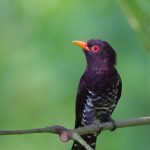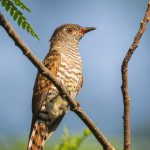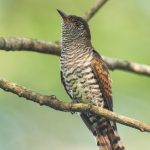The Violet Cuckoo (Chrysococcyx xanthorhynchus) is one of the rarer resident cuckoos in Singapore. It is more often heard rather than seen. And when it is seen and identified, it is mostly flying away! One of the lessons I have learned along the way in finding this cuckoo is to learn its call. It is been described as a loud, spaced and repeated “ter-weet’ That is normally heard while it is flying around or on top of canopy of tall trees.
The Violet Cuckoo is named after the appearance of the adult male bird, which has an attractive glossy violet feathers on the head and upper parts of the body. The degree of violet depends very much on the angle of light and can appear very dark. Interestingly the scientific name xanthorhynchus actually means ‘yellow-billed’ which is also a characteristic of the adult male. The female and the juvenile differs markedly from the male with the female having a dark, brown crown and greenish-bronze upperparts. The juvenile has a rufous crown and barred rufous and greenish bronze upperparts.
Recent sightings in Singapore of this cuckoo include areas such as Pasir Ris Park, Bukit Brown, Dairy Farm Nature Park, Kent Ridge Park, Hindhede Park, Jelutong Tower, Neo Tiew Lane 2, Bukit Timah and Jurong Eco Garden.
In fact the last place, Jurong Eco Park was where a male Violet Cuckoo was seen regularly for close to 3 months between end October 2014 to January 2015. The reason it was there was because of the abundance of caterpillars, which is one of its main diet. This regular appearance was a boon to bird photographers who managed to record many photos of the bird. The previous extended display of this bird was in January 2011 at Pasir Ris Park where one bird was seen daily feeding on caterpillars. This is one of the peculiar thing about this species of cuckoo. For the better part of the year, they are hard to find, but once there is a suitable and sustainable food source, they appear regularly until the food source is depleted.
There is speculation that some of the birds recorded in the winter months are in fact migratory birds. This however is hard to prove. Nonetheless the dates of appearance of these two adult male birds seen for prolonged period of time are within the wintering months.
Although many pictures and videos have been posted on this species, there is still much to learn about it’s behaviour. For example, it is known that like many cuckoos, it is a brood parasite that lays its egg on the nest of another species. In Singapore, there are past reports of hosts including the Brown-throated Sunbird, the Van Hasselt’s Sunbird and the Olive-backed Sunbird. Pictures and videos of these species interaction will be valuable indeed.
Photo Gallery:
- The male Violet Cuckoo showing well it’s back. Taken at Jurong Eco Garden. Notice the leaves that have been eaten by the caterpillars.
- A male Violet Cuckoo with a caterpillar.
- A front side view of the male Violet Cuckoo.
- A side view of the male Violet Cuckoo.
- A young female Violet Cuckoo. The crown is brownish. This was taken at Neo Tiew Lane 2.
- Another view of the young female Violet Cuckoo. It’s appearance stands in contrast to the more striking adult male.
Video:
The secondary call of the Violet Cuckoo is less known. I made a recording of this call on 28 October 2014 at Jurong Eco Garden.





